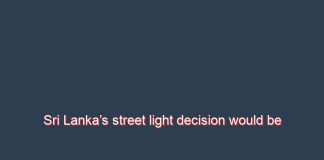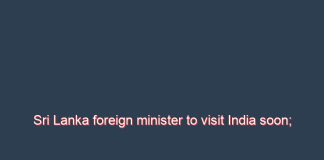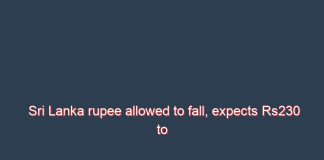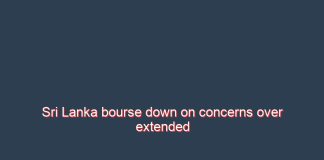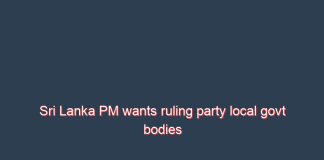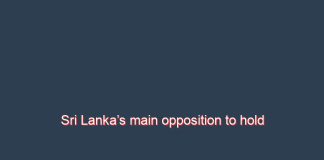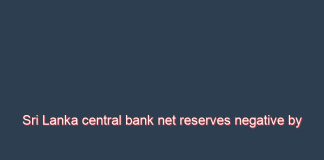Sri Lanka’s street light decision would be setback for female labour...
ECONOMYNEXT- Sri Lanka government’s decision to switch off lights in Local Government area would be a setback for the attempts to increase the female labour force participation (FLFP), a Colombo-based think tank economist said.
Finance Minister Basil Rajapaksa on Monday instructed heads of local government authorities across the country to turn off street lights in their areas to conserve electricity due to the prevailing energy crisis.
“The move to switch off street lights at night would make women feel less safe and it would be a setback for attempts to increase the FLFP rate in Sri Lanka,” Nisha Arunatilake, an economist at Institute of Policy Studies said in the think tank’s twitter feed.
Though women account more than 50 percent of the Sri Lanka’s 22 million population, only 34.5 percent of the women are in the labour force.
Though FLFP has been on the rise, still there are a number of barriers for women to be in active labour force including concerns over their security as well as social stigma and culture.
Night shifts in super markets and nursing homes have increased employment opportunity for women while increaseingthe FLFP in Sri Lanka.
However, the power cuts in the night time coupled with lack of transport facilities due to fuel shortage have threatened the FLFP and more women doing jobs in night shifts.
Finance Minister’s Monday announcement came as the country has severe dollar shortage to purchase fuel.
Local government authorities Economy Next spoke to said they are still waiting for proper direction from the government on the decision. (Colombo/March8/2022)
Sri Lanka rupee bid at Rs230 to dollar, no two-way quotes...
ECONOMYNEXT – Sri Lanka’s rupee is bid at 230 to the US dollar in the interbank market with no offers despite a float being allowed by the central bank amid mandatory conversions and surrender requirements.
There were no two way quotes in the interbank market by 1400hours of on March 08, for the exchange rate to float, despite Central Bank Governor Nivard Cabraal saying the rupee had been allowed to float.
There were only bids at 230 and no offers.
Exporters who converted dollar at around 202 on Monday are converting from around 224 to just under 230 on Tuesday, based on mandatory conversion rules, market participants said.
“There is no direct central bank pressure to maintain the 230 rate,” a market participant said. “But banks are too nervous to bid higher, due to certain reasons.”
Central Bank Governor Nivard Cabraal told EconomyNext the 230 to the dollar rate was “guidance” and the rupee was floated.
In past floats after money printing crises, there had been offers at higher levels and some moral suasion had come when bids completed the transaction. During the current crisis however there are bids but no offers.
On Tuesday banking and exporter circles were scrambling to find money for an oil ship anchored off Colombo Port.
Former Deputy Governor W A Wijewardene said the rupee had to be floated for forex market to return to normal and if it is re-pegged at 230 the market will not solve the problem.
“In principle allowing the exchange rate is the right move,” Wijewardena said. “But if this is a devaluation and they try to keep at 230 it will not eliminate the parallel exchange rates. The kerb rate will simply go up.”
Analysts had warned that existing surrender rules may hurt the rupee.
Countries with soft-pegged central banks have forex shortages due to liquidity injected for multiple reasons. The central bank is now printing money to sterilize interventions, which will stop if a float takes hold. (Colombo/Mar08/2022)
Sri Lanka foreign minister to visit India soon; India assures continued...
ECONOMYNEXT – India’s external affairs minister S Jaishankar has assured Sri Lanka’s finance minister Basil Rajapaksa of continued support, and a mutually convenient date is to be finalised for the latter to visit India in the second half of March, the High Commission of India in Colombo said.
The high commission tweeted Monday (07) night that the two ministers had a productive and cordial telephone conversation, in which Jaishankar had given his assurance that India will “continue to support Sri Lanka in all possible ways”.
EAM @DrSJaishankar and Hon’ble Finance Minister @RealBRajapaksa had a productive and cordial telephone conversation a while ago. EAM assured that #India will continue to support #SriLanka in all possible ways. They agreed to finalize a mutually convenient date in the second(1/2) pic.twitter.com/wTX2jTjtoS
— India in Sri Lanka (@IndiainSL) March 7, 2022
The announcement followed a report in Sri Lanka’s weekend English newspaper The Sunday Times that India had called for an economic road map or action plan aimed at long term economic recovery and to “clear the decks for a long list of its economic cum strategic demands for implementation in the North and the East of Sri Lanka” in order to release a one billion US dollar emergency loan for essential supplies.
Finance Minister Rajapaksa had twice cancelled a planned visit to India after initially securing a 500 million US dollar loan in December 2021, which was to be paid in early March.
According to the Sunday Times report, the Indian demands centre a number of maritime security agreements, particularly around the Trincomalee harbour. “These include Donier surveillance aircraft for the Sri Lanka Air Force, a ship repair dock for the Sri Lanka Navy in Trincomalee and posting of a Sri Lankan Navy officer at the Intelligence Fusion Centre, a Bahrain-based intelligence sharing office which is a US Navy initiative to combat international terrorism, the narcotics trade and ensure safe maritime passage for commercial vessels in the region,” the newspaper reported.
The call between Jaishankar and Rajapaksa came hours after Sri Lanka’s central bank said it is abandoning a 200 to the US dollar peg after printing money though multiple means which were making outflows greater than inflows, creating forex shortages and parallel exchange rates.
Sri Lanka rupee allowed to fall, expects Rs230 to dollar rate: Central Bank
Sri Lanka’s forex markets are braced for a float of the rupee after the central bank said it will no longer hold the rupee at 200 to the US dollar, amid suggestions that further monetary tightening is needed to prevent a steep fall of the rupee.
Sri Lanka braced for a float of the rupee amid call for tighter policy
(Colombo/Mar08/2022)
Sri Lanka rupee allowed to fall, expects Rs230 to dollar rate:...
ECONOMYNEXT – Sri Lanka’s central bank said it is abandoning a 200 to the US dollar peg after printing money though multiple means which were making outflows greater than inflows, creating forex shortages and parallel exchange rates.
The central bank said “greater flexibility in the exchange rate will be allowed to the markets with immediate effect.”
“The Central Bank is also of the view that forex transactions would take place at levels which are not more than Rs. 230 per US dollar.”
The rupee is trading in the kerb market around 249 to the US dollar. Exporters have been selling unofficially around 245 to the US dollar.
It is not clear whether the 230 rate will be controlled or it will be a allowed to free float.
Devaluations are hit or miss affairs, analysts say, unlike a clean float which is followed by a steep rate hike to curb domestic credit which succeeds every time.
The current statement came after a 100bp rate hike, which is still far below inflation of 15.1 percent with the budget deficit also around 10 percent of gross domestic product.
Related
Sri Lanka has to hike rates, tourism recovery will not help end forex crisis: Bellwether
The earlier 200 to the dollar non-credible peg was only partially defended through ‘reserves for imports’ leading to forex shortages.
The central bank has surrender requirements, which can undermined the exchange rate, analysts say.
The central bank has lost reserves after record money printing to keep interest rates artificially low and the ability to defend the currency peg.
The full statement is reproduced below:
Policy package to support greater macroeconomic stability: Allowing flexibility in the exchange rate
Considering the severity of the external shocks and recent developments in the domestic front, the Monetary Board of the Central Bank of Sri Lanka announced a comprehensive policy package on 04 March 2022 with the view to counter such economic headwinds.
The Central Bank also indicated that it will continue to closely monitor the emerging macroeconomic and financial market developments, both globally and domestically, and will stand ready to take further measures as appropriate, with the aim of achieving stability in the fronts of inflation, the external sector, the financial sector, and real economic activity.
In that context, greater flexibility in the exchange rate will be allowed to the markets with immediate effect. The Central Bank is also of the view that forex transactions would take place at levels which are not more than Rs. 230 per US dollar.
The Central Bank will continue to closely monitor the developments in the domestic foreign exchange market and make appropriate policy adjustments accordingly.
Sri Lanka bourse down on concerns over extended power cuts, economic...
ECONOMYNEXT – Sri Lanka’s main All Share Price Index (ASPI) lost 2.5 percent on Monday (07) to a more than one-week low as concerns over extended power cut and economic weighed on the risky assets amid fears over the sustainability f country’s power supply due to forex shortage and rise in Brent crude, brokers said.
The (ASPI), fell 283.00 points to close at 10,960.49, its lowest since February 24.
“What happened was Brent Crude hit close to 130 dollars today and the global equity market reacted. So did the Sri Lankan,” a market analyst said.
High oil price has hit Sri Lanka’s economic growth in the past and manufacturing sector is affected hard and company earnings fall due to high cost of production and lower consumption due to high energy cost.
Finance Minister Basil Rajapaksa on Monday urged local government authorities to switch off street lights to conserve the energy at least until March 31.
“People expected the power crisis to be resolved by March 06. However, when the news of street lamp being cut came up that also acted as a factor on top of the uncertainties in the market already.”
On Friday (04) Sri Lanka’s central bank raised the key monetary policy interest rates by 100 basis points to more than a two-year high in a bid to reduce pressure on the currency that was created by excess money printing while keeping the interest rates at a low level to spur pandemic-hit economic growth.
In February, the market has lost 11 percent and overall the market has lost 10.4 percent so far this year after being one of the world’s best stock markets with an 80 percent return last year. The main index, however, gained 1.2 percent last week.
S&P SL20 of the most liquid stocks is also down 2.75 percent or 105.16 points to 3,714.28 points.
The market turnover was 3.5 billion rupees, around half of this year’s average turnover of 6.0 billion rupees.
Foreign investors, who are highly worried about possible sharp depreciation or devaluation in the currency, bucked the trend to buy 150.2 million rupee worth shares. The foreign sales so far this year has been 2.9 billion rupees. In 2021, the Sri Lanka stock market suffered a net foreign outflow of 50 billion rupees.
Analysts predict, the downward trend to continue until investors see some strong and sustainable steps to address the economic and foreign debt crisis.
LOLC Holdings, Expolanka, and Browns Investment dragged the main index to it’s fall on Monday.
LOLC Holdings slipped 4.31 percent to close at 900.00 rupees a share, while Expolanka Holdings, the market heavyweight lost 3.47 percent to close at 271.00 rupees a share, market data showed.
Browns Investment closed down 5.13 percent at 11.10 rupees a share. (Colombo/March07/2022)
Sri Lanka PM wants ruling party local govt bodies to turn...
ECONOMYNEXT – Prime Minister Mahinda Rajapaksa has requested all local government leaders that represent the ruling Sri Lanka Podujana Peramuna (SLPP) to turn off street lamps until March 31 to help conserve electricity as the island nation goes deeper into a power crisis.
Writing to all heads of local government bodies, group leaders and opposition leaders on Sunday (06), Prime Minister Rajapaksa called for their assistance in what he called the “national duty” of conserving electricity.
Sri Lanka is in the midst of one of the worst energy crises in the country’s history, with daily power cuts as long as seven and a half hours in some areas as the state-run Ceylon Electricity Board (CEB) struggles to find fuel to generate thermal power in the absence of rain for hydro power generation.
The crisis is the result of an ongoing fuel shortage which in turn has been caused by a severe forex shortage brought about by excess money printing to keep interest rates low in a pegged exchange rate regime.
In his letter, Rajapaksa has attributed the power crisis to lack of rainfall, the rise in global oil prices, and the forex shortages in the country.
“One way to manage this challenge is to use electricity carefully on a basis of priority. To set an example of that, I kindly ask you to switch off all street lamps in your constituency until March 31.
“In addition to that, if there are other means of conserving electricity in your respective area causing minimum inconvenience to the public, I ask that you implement them and report to me,” he said. (Colombo/Mar07/2022)
Sri Lanka’s main opposition to hold demonstration on March 15 in...
ECONOMYNEXT – Sri Lanka’s main opposition the Samagi Jana Balavegaya (SJB) will hold a demonstration on March 15 in Colombo against the rising cost of living and the multiple crises the country is facing, SJB general secretary Ranjith Madduma Bandara said.
The MP told EconomyNext that the protest will focus on rising prices, fuel and gas shortages and the ongoing power crisis.
Pockets of protests – some public, others organised by opposition parties – have been springing up across Sri Lanka over the various crises the country is currently battling as a result of a crippling dollar shortage.
All organisations affiliated with the SJB will join the protest, the MP said. Asked if any defectors from the government can be expected at the event, Madduma Bandara answered in the negative.
A separate protest that was to be held in Anuradhapura at the end of this month has been postponed, he added.
The last SJB protest against the government organised on November 16 met resistance, with police turning away some protestors marching into Colombo.
Sri Lanka opposition protests: crowds gather as police promises to act
(Colombo/Mar07/2022)
Sri Lanka central bank net reserves negative by US$3.2bn in Jan...
ECONOMYNEXT – Foreign exchange liabilities of Sri Lanka’s central bank has exceeded its reserve assets by 662 billion rupees (US$3.29bn) in January 2022, up from 386 billion rupees (US$1.9bn) a month earlier as it got deeper into debt to repay debt and provide reserves for imports, official data show.
In January 2021 Sri Lanka’s gross official reserves, which includes fiscal reserves if there are any, fell to 2,361 million dollars from 3,139 million dollars.
The central bank stands to make large quasi-fiscal losses as soon as the rupee falls raising questions about its ability to conduct monetary policy.
There have been warnings that the central bank could lose control of reserve money and the country could end up in full dollarization like in several Latin American nations.
Though various claims are made, a central bank only has control over one variable – reserve money or the monetary base.
The International Monetary Fund has also warned that the central bank may lose control of money and the economy could implode unless money printing is stopped.
“Unless the fiscal and balance-of-payments financing needs are met, the country could experience significant contractions in imports and private credit growth, or monetary instability in case of further central bank financing of fiscal deficits,” an IMF statement said after annual consultations.
RelatedSri Lanka money printing, deficits could lead to economic implosion: IMF report
The IMF said Sri Lanka’s public debt including of central bank liabilities had risen to 119 percent of gross domestic product.
The central bank has about 1.2 billion dollars of loans due to the IMF from previous currency crises.
Sri Lanka usually has a negative balance to the Asian Clearing Union as well.
The central bank has also given reserves for imports as money printing created forex shortages and sterilized them at 6.5 percent adding more rupee reserves into the banking system.
Reserve money is continuing to grow despite reserve sales for imports to maintain the 200 to the US dollar peg and inflation has hit the highest since 2008.
The central bank has been following highly discretionary inflationary policy from around the third quarter of 2014, leading to a series of currency crisis from so-called stop go policies (printing money and hitting the breaks when the balance of payments fell apar).
From after 2015 deadly call money rate targeting was started (printing large volumes of money to generate excess liquidity and short term rates from hitting the policy ceiling) as soon as credit picked up from the last currency crisis, as well as REER targeting (depreciating the currency to cut real wages and give zero-sum profits to export firms) and output gap targeting (printing money to boost growth).
The IMF gave technical support to Sri Lanka’s trigger happy central bank to calculate the ‘output gap’ which will be used as a tool to print money under so-called data driven monetary policy despite operating a reserve collecting peg, triggering balance of payments deficit.
As inflationary policy triggered forex shortages making it difficult to repay maturing dollar debt as Asset Liability Management Law to borrow more dollars. The CPC which also ran short of dollars as the central bank printed money, borrowed more dollars through suppliers credit.
In 2020 output gap targeting turned into what was termed Modern Monetary Theory as extreme form of ‘go policy’ with reserve ratios and rate cut even as budget deficits ballooned with tax cuts in a bid to create a ‘production economy’, blowing the balance of payments apart.
Analysts warned that the monetary policies were similar to those of German Social Democrats during Weimar Republic and dollar debt default will be the result.
Like the CPC and the central government, the central bank also borrowed dollars mainly through swaps as liquidity injections created for shortages. In 2021 it also got a special drawing rights tranche from the IMF.
After MMT ‘go’ policy the central bank is now trying to hit the brakes, with policy rates hiked 100 bp last week to 750 percent. But money is still being printed to sterilize interventions and also give subsidies to expat workers who remit money through the banking system. (Colombo/Mar08/2022)
Sri Lanka tea exports drop 6.9-pct in Jan 2022, Iraq, Russia...
ECONOMYNEXT – Sri Lanka’s Ceylon Tea exports fell 6.91 percent in January 2022 to 19.38 million kilograms from 20.82 million kilograms from a year ago, with Russia and Iraq the top buyers, industry data showed.
Purchas by China had dropped from 1.5 million kilograms in January 2022 from 738,000 kilograms last year.
The island’s tea production has dropped 0.36 percent in January 2022 to 22.82 million kilograms from 23.18 million kilograms in 2021.
“Elevation wise analysis shows that for the month of January 2022 Low Growsn had recorded a decrease of 1.53 million kilogram whilst High & Medium Growns recorded an increase of 0.59 million kilogram and 0.58 million kilogram increase respectively when compared to the same period in 2021,” Ceylon Tea Brokers, a Colombo-based brokerage said in a report.
The free on board (FOB) price per kilo for the month of January 2022 was 948.24 rupees, up from 923.99 rupees a year earlier.
The January monthly average price for tea was 3.50 US dollars (704.67 rupees) compared to 3.30 US dollars (645.02 rupees) in January 2021, according to Ceylon Brokers data.
“Total export earnings shows a decrease of 0.86 Billion rupees (-4.46%) for the month of January 2022 as against the corresponding month in 2021,” Ceylon Tea Brokers said as the volume drop outpaced price gains.
The average price was 4.70 dollars a kilogram in January from 4.62 a year earlier.
Iraq was the top buyer of Ceylon Tea in January buying 3.80 million kilograms, up from 1.79 million a year earlier.
Meanwhile Russia remained at the second place buying 2.56 million kilogram higer than pervious year’s 2.46 million kilogram.
UAE bought 2.03 million kilograms, up from 1.11 million last year.
The crisis hit Libya bought 1.13 million kilos in January 2022.
Turkey who was a key buyer in 2021 slipped to 10th place buying only 0.52 million kilogram from the corresponding years 3.82 million kilogram.
China, which had been an emerging key buyer bought only 0.74 million kilograms compared to 1.51 million kilogram last year. CIS countries bought 1.06 million kilos, down from 1.07 million last year.
(Colombo/Mar07/2022)
Sri Lanka Transport Board to re-fuel private buses, more diesel promised
ECONOMYNEXT – State-run Sri Lanka Transport Board will pump fuel for privately owned buses from Monday, as forex shortages coming from money printed by the central bank to maintain low interest rates made it difficult to import oil.
Chirman of state-run Ceylon Petroleum Corporation Sumith Wijesinghe said the firm had started delivering fuel to SLTB pumping stations following discussion with newly appointed transport minister Dilum Amunugama.
Private bus owners had requested fuel from SLTB to avoid being in queues with the rest of the public.
“There are 1200 CEYPETCO fuel stations and 210 IOC fuel stations,” Wijesinghe said. “We gave the facility for the bus owners to get diesel from these stations.
“We had the discussion on Friday (4), and we have started deploying fuel for CTB fuel stations and by Monday or Tuesday we will be able to complete it.”
Sri Lanka is facing delays in unloading fuel due to foreign exchange shortages coming from money printed by the central bank. The central bank has been giving reserves for imports at a 200 to the US dollar peg, but has been printing money at 6.5 percent to prevent rates from going up.
Last week the rate was hiked to 7.5 percent. Money is also being printed to given a 8 rupee per dollar subsidy to expat workers sending dollars through banking system, which boost imports and boomerang on the reserves of the central bank.
Further rate hikes and float of the currency is needed to end forex and fuel shortages, analysts say.
There have been calls to change the governing law of the central bank to prevent its domestic operations department from printing money to keep interest rates artificially low, trigger currency crises and social unrest.
Related
Sri Lanka central bank hikes policy rate 100bp to counter forex crisis
Meanwhile Wijesinghe said, fuel supply for the agricultural areas will also be boosted.
” The agriculture minister requested us to provide adequate fuel for the agriculture areas in the country,” Wijesinghe said.
“With that we deployed fuel for those areas, not only in western province but also in other areas as well. From yesterday till tomorrow we will deploy these fuels.”
The general public was stocking more fuel than in the past and are also running generators, boosting demand.
“People are using more fuel than they usually started stacking up extra fuel in cans and barrels. This is the cause for shortage of fuel in the country” Wijesinghe claimed
“We have now started unloading fuel for the consumption in the country. And the ques are getting shorter and by the end of the day it will settle.
“We did not say that we don’t have enough fuel since we had enough fuel for the daily consumption with us. So we ask the general public to not to panic and use fuel as usual.”
Wijesinghe said, from each fuel ship, CPC received 35- 40,000 metric tons and for the monthly consumption Sri Lanka needs around 200,000 metric tons of Diesel.
Asking the general public to preserve fuel without overconsumption, he said, the price of fuel has gone up to a record high in the international market, mainly due to Russia – Ukraine conflict.
However, Wijesinghe said, CPC has ordered the necessary amount of all types of fuel for daily consumption.
“And on next Monday and Tuesday we will receive more diesel consignments. And all the fuel we need, including furnace oil, Jet AL, Diesel and etc we have placed orders” Wijesinghe said.
“We responsibly say there won’t be any shortage of fuel in the coming days.”
Commenting on the ongoing power crisis due to shortage of furnace oil and diesel, Wijesinghe said, as agreed in the discussions held with Ministers of Power and Electricity, CPC will start supplying necessary furnace oil and diesel stocks from Monday onwards.
“We are having meeting on Saturday (5) and we will finalize on how to continuously supply the necessary fuel to CEB” WIjesinghe said.
“CEB said, with demand decreases in the weekend, it can be managed with the current stocks they have and from Monday onwards we will supply the needed diesel and furnace oil for power generation without any interruption”. (Colombo/ March 5/2022)
